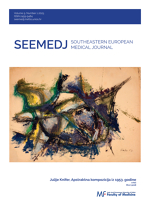Hypodermoclysis in Palliative Care
DOI:
https://doi.org/10.26332/seemedj.v9i1.356Ključne riječi:
drug therapy, fluid therapy, parenteral nutrition, subcutaneous infusionSažetak
With the aging population, the prevalence of oncological and other incurable chronic diseases is increasing, which raises the demand for palliative care. Patients in the final stages of illness often experience reduced food and fluid intake, leading to dehydration, while impaired swallowing hinders the oral administration of medications. Traditionally, fluid replacement is performed via intravenous (IV) routes; however, in elderly patients with long-term comorbidities and compromised veins, establishing venous access can be challenging and traumatic. Subcutaneous infusion, also known as hypodermoclysis, represents a simpler and less invasive alternative, especially in palliative care.
Hypodermoclysis enables safe and effective administration of fluids and medications into the subcutaneous tissue, reducing the need for repeated venipunctures and minimizing patient discomfort. This method has a long history, first being described in 1865 during a cholera epidemic. Despite its longstanding use, it is still not widely recognized among healthcare professionals. Its advantages include ease of application, lower costs, and the potential for use in home settings, allowing patients to remain in a familiar environment.
This study involved a literature search in databases such as PubMed, Scopus, and Web of Science, focusing on research published after 1995. A total of 401 studies, including meta-analysis, review articles, and clinical trials, were analysed to assess the efficacy and applicability of subcutaneous infusion in palliative care. The results indicate that hypodermoclysis is a suitable method for fluid replacement and medication administration, with a lower risk of complications compared to intravenous therapy.
Subcutaneous infusion is a safe, effective, and easily applicable method in palliative care. Its wider application can improve the quality of life for patients in the terminal stages of illness, reduce unnecessary medical procedures, and facilitate care in home settings with the active involvement of family members and palliative care teams.
Preuzimanja
Objavljeno
Broj časopisa
Rubrika
Licenca
Autorska prava (c) 2025 Southeastern European Medical Journal

This work is licensed under a Kreativni Commons Attribution-NonCommercial-NoDerivatives 4.0 International License.



